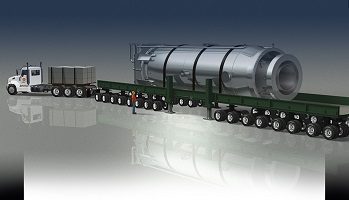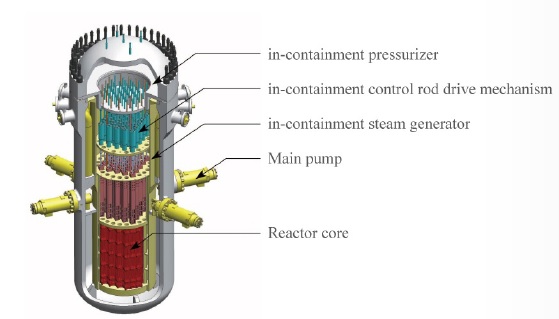Salvation by SMR: The Industry Gets Closer
by Will Davis, from the American Nuclear Society 2018 Annual Meeting in Philadelphia
Long in coming has been the Small Modular Reactor nuclear plant; widely assured as the 'next big thing' for nuclear energy, the development of this variety of plant has been much more protracted than would be liked in many circles. It's important to have it, but it's also important to have it right - because, frankly, we'll probably need it.
"The SMR is the single key to the revitalization of our industry," said Dr. Kris Singh today as his General Chair's Special Session on Small Modular Reactors kicked off. Singh pointed out that in many parts of the world today many things formerly not available are in fact easily available, such as shoes and eyeglasses, but that what's not available at all in many places is that thing we need to have quality of life: Energy. In fact, according to Singh, we only are generating about 30% of the energy we actually need worldwide to give everyone a decent standard of living. The SMR is that carbon-free tool that many places around the world might need to raise the standard of living as well as stimulate industry, he said, but it needs to be economical (and in fact intrinsically competitive with other power sources cost-wise) and - above all - it needs to be unconditionally safe.
While it's true that various types of advanced reactors have been touted as inherently safe (such as gas cooled and sodium cooled reactors) they're not really ready to take the stage yet. As with the first go-around, light water is ready first - well, perhaps not on stage yet but certainly in the wings. Two light water designs are, we learned today at Dr. Singh's very informative session, now considered to be walk-away safe; the NuScale reactor already well known in the industry and, now, the Holtec SMR-160. As Singh pointed out, a fundamental requirement of "unconditional safety" is the acknowledgement that any published measurable core damage frequency for a reactor design, no matter how tiny, is an admission that core damage is possible and, to be "unconditionally safe," it must not be possible at all.

South Korea's SMART SMR design displays the now-classic form of today's light water SMR - the iPWR or "Integral Pressurized Water Reactor" concept wherein core and steam generators are in one vessel. NuScale is a natural circulation variation of this, while the Holtec / SMR LLC SMR-160 has an external steam generator.
Of course, there are fundamental barriers facing SMR's that aren't unique to them; as Singh observed, "A reactor may be small, but the review (in order to license it) is still very big!" Stuart Crooks, Managing Director of the Hinkley Point C project in the UK - which is decidedly not an SMR but is very new - pointed out to the assembled crowd that Hinkley Point's units are essentially the fifth and sixth units of a completely standardized design of nuclear plant and, yet, took 66 months in design review in the UK. Clearly, there must be some better way to license reactors he opined and more than one speaker brought up universal licensing of one or another form. The flight certification of aircraft was brought up as one example and, while the problems with accepting an outside body's licensing of a design are clear, there can be no acceptance of the review timetable in the UK given that these plants are so far down the stream without at least a raised eyebrow. Something, it would seem, has got to be better.
Interestingly, directly related to Small Modular Reactors, Crooks mentioned that the UK program to build SMR's has almost reached another important milestone as very soon it will be announced whether the UK will buy or develop SMR's for construction there. He pointed out that at least one UK study showed no cost benefits for SMR nuclear plants, and that there is thus a desperate need to cut licensing and expected construction time for such plants. He did say that the UK needs to add roughly 7 GWe of electric power generation and that while there are certainly a number of GW-scale plants planned, small plants are definitely still in the running.
Dr. Kathryn McCarthy, Vice President of R&D and Lab Director at Canadian Nuclear Laboratories (which she pointed out used to be much more well known as Chalk River) pointed out that siting of these new small plants is a wide open field, so to speak, but that it's absolutely vital to ask potential hosting communities about their interests and concerns very early in any program. Canada, she said, has right now hundreds of remote communities which rely solely on diesel power for their electricity. Nuclear could cleanly solve that problem, but of course early and meaningful dialogue with the community would be essential. McCarthy also noted, in the same spirit of open exchange so common to Canadians, that the regulator has a "Vendor Design Review" exercise which is completely optional for those concerns preparing to submit a nuclear plant design for certification. This VDR allows the vendors and regulator to come together very early in the process, and provides feedback on any potential issues which might be encountered once the formal licensing process has begun. She said ten designs are in review now, and while she could not reveal names, there have been both Canadian and international firms making it to later stages of the process. CNL plans to host several types of SMR at its own sites eventually.

SMR on trailer courtesy NuScale Power
Dr. Jose Reyes, well known as the face of NuScale Power (not to mention being co-founder and Chief Technology Officer) then told the audience that he expects NuScale plants to have a three year build time from the time the first concrete is poured. He echoed the call for changes in licensing as he quoted the $500 million it took just to get the innovative NuScale integral reactor design through to the submission for Design Certification, which process is still ongoing. Phase 1 of the NRC's review, he said, is completed and NuScale hopes to receive Design Certification in January 2021 - this in advance of constructing units for UAMPS at the INL site in Idaho in the 2025-2026 time frame.
Competitive with the NuScale reactor in some ways is the SMR-160, developed by SMR LLC. This unit is not integral however; it has an external steam generator coupled to the reactor module by a concentric pipe arrangement which, when the height above the reactor of most of the steam generator is considered, allows natural circulation flow. The SMR-160 will have just a 4.5 acre site area, and like the NuScale design is intended to be fully walk-away safe. (Reyes described the walk-away shutdown cooling of the NuScale design as first, water cooling, then boiling water cooling, then air convection - all without human intervention. The SMR-160 also relies on natural circulation for its walk-away phase but unlike the NuScale design is not submerged in water itself yet, according to Thomas Marcille of SMR LLC, the unit cannot possibly have the core become uncovered by water.) It was also noted that there are serious discussions underway now with ENERGOATOM of the Ukraine to construct up to six SMR-160 units at the Rivne NPP to replace older VVER units of the Soviet era which will eventually have to shut down; this is planned for the 2026 time frame, which is very close to that stated for the NuScale UAMPS units in Idaho.
So, while long promised, we'll still have to wait a few more years for the first US-built Small Modular Reactor Plants. What's encouraging is the broad approach, the wide acceptance, and the order for one type and potential (probable?) order for another which will if completed see both designs built by the middle of the next decade. That may seem long to some, but it may not be too long to wait to get the ideal solution correct. The SMR's will have to deliver on their promises the first time around.

CNNC's ACP100 design is shown here. The heart of the SMR concept is that the entire unit as seen here is factory fabricated and pressure tested, then delivered to the site 'ready to go,' minus nuclear fuel. Initial fueling and nuclear startup will still have to take place at the power plant site, not at the factory. As mentioned by Jose Reyes, part of what cuts build time is that from the day of a customer's order the nuclear portion is being built at a factory while the plant construction occurs simultaneously on site - meaning that the two processes never interfere with each other. NuScale expects a 36 month build time, concrete to fuel load.


